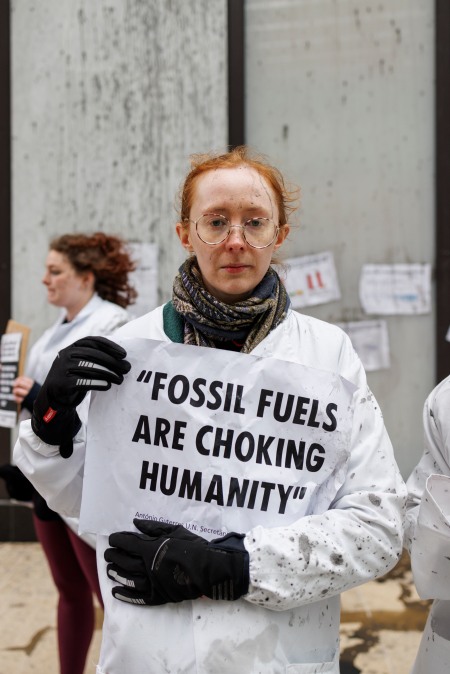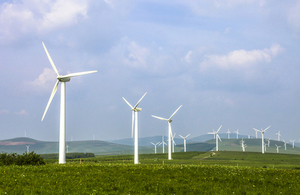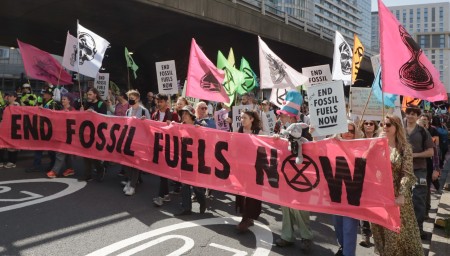From People and Nature.
In this guest post, PETER SOMERVILLE examines the UK government’s “energy security strategy”
The UK government’s energy security strategy avoids bold measures to decarbonise the economy. Its claimed aims are to “build a British energy system that is much more self-sufficient” (page 6), and specifically to “reduce our dependence on imported oil and gas” (page 5) – but it will not even do that effectively, either.
Broadly, the strategy, published last month, fails in four ways:
Firstly, the strategy provides insufficient support for the development of renewable energy, given the urgency of the climate and energy crisis.
In comparison, its support for so-called “low carbon” development looks both disproportionate and less certain of achieving the immediate progress that is now required. Taken together with its support for new gas projects, this is difficult to explain except in terms of the power of the nuclear and fossil fuel lobbies, which effectively remains unchallenged. The strategy doesn’t even begin to get to grips with nature-based solutions.
Secondly, the strategy has very little to say about reducing energy demand, e.g. from retrofitting, by reducing car use, by stopping airport expansion, and so on. It doesn’t mention increasing carbon tax on industry as one means to encourage a shift towards using renewable energy instead of fossil fuels.
Even that would not be enough, however. More radical ways forward need to be considered, such as new forms of public and community ownership; rapid, binding targets for phasing down and phasing out fossil fuels, cap and share schemes,[1] and much more.
Energy rationing may sound drastic but it would be a clear way forward and may well become necessary in time. In the meantime, a windfall tax on the big energy companies and a wealth tax would be useful for meeting people’s immediate needs.
Thirdly, the strategy has nothing to say about how the impending climate crisis will affect energy security, e.g. droughts and floods affecting energy generation and supply.
Fourthly, the strategy is not joined up with the rest of what the government is doing. Overall, this strategy looks incapable of achieving its aims: the government is not on course to meeting its climate policy targets, it has no clear understanding of how it can get on course, and some of its targets are not ambitious enough while others are inappropriate.
As the energy policy researcher Michael Grubb writes in the Financial Times: “The defining feature of the UK energy strategy is its incoherence. It doesn’t know what problem it is trying to solve — and thus it doesn’t solve any.” And Ravishaan Rahal Muthia of Greenpeace writes that it is “leading us to a dead end”.
Promises in the strategy are to:
1. License new gas projects in the North Sea and review the potential for shale gas onshore (page 15).
2. Build domestic renewable energy capacity (wind and solar).
3. Build domestic “low carbon capacity” (nuclear; hydrogen; carbon capture, use and storage (CCUS))
4. Reduce gas consumption by more than 40% by 2030 (page 14).
5. Decarbonise electricity, buildings and transport, to get off gas and oil.
6. Plant trees.
7. International: provide climate finance.
Let’s go through those, one by one.
Promise 1. License new gas projects in the North Sea and review the potential for shale gas onshore.
The reality: This proposal flies in the face of what is needed, which is to cease all new gas and oil exploration and extraction immediately, as urged by the International Energy Agency and the United Nations Environment Programme. As Carbon Tracker says:
Planning a power system centred around lower cost renewables with battery storage not only represents the best option in terms of climate target progress, but also in cutting exposure to commodity price volatility and stranding risk.
The UK gets only 4% of its gas from Russia, and 11% of its oil, so dependence on Russia is not an issue. However, for some years, the UK will continue to be dependent on other countries for fossil fuels (e.g. oil from Norway) and for solar panels and batteries (mainly from China), so energy security will continue to be uncertain.
Arguably, this proposal will reduce, not increase, UK’s energy security, because of the risk of stranded assets.
Promise 2. Build domestic renewable energy capacity (wind and solar).
The reality: Offshore wind: The increase in ambition from 40GW to 50GW capacity by 2030 (page 16) is to be welcomed, but it is not enough. Up to 100GW will be needed by 2038 for a fair contribution to electricity decarbonisation, the Campaign Against Climate Change (CACC) estimates. Speeding up the planning process is also helpful (from 4 years to 1 year), and having annual auctions. Cost to government: £320 million on support for fixed bottom and floating wind ports and infrastructure (page 7).
Onshore wind: The government lacks commitment here, with the planning system continuing to be a significant obstacle to development. Responsibility is being passed to local authorities with the addition of a reference to the prospects for partnerships with “a limited number of supportive communities” (page 18), e.g. the Octopus Fan Club (which is seeking £4 billion for wind turbines for 2.5 million households by 2030).
The government is simply not recognising that the potential for onshore wind energy is at least as great as for offshore wind. Cost to government: zero.
Michael Grubb’s criticism in the Financial Times doesn’t pull any punches here:
The most cowardly failure concerns onshore wind. It is not only our cheapest energy resource – it typically costs about a third to a quarter of what people will soon be paying for their electricity – but it is, with solar, the only one that could make a dent in the short term.
Solar: The picture here appears more encouraging, with a target of a 5-fold increase by 2035, from 14 to 70GW, especially on roof solar, and a presumption that renewables including solar PV will be installed as standard in new homes and buildings. However, no substantive support is being offered for existing homes to reach this target, but only: “We are looking at facilitating low-cost finance from retail lenders to drive rooftop deployment and energy efficiency measures” (page 19).
And on ground-mounted solar, there is a commitment only to “consult on amending planning rules to strengthen policy in favour of development on non-protected land, while ensuring communities continue to have a say and environmental protections remain in place”. As with onshore wind, therefore, the potential for solar energy is there but the government is proposing little to realise it. Cost to government: zero.
Overall, despite a considerable amount of rhetoric, the government’s real support for renewable energy falls woefully short of what is required to ensure society-wide decarbonisation.
The CACC, for example, suggests that at least 300GW of renewable energy capacity is required to ensure that the UK’s energy is entirely clean – for electricity, industry, heating and transport.
And as far as security is concerned, the strategy does not consider the potential for domestic production of materials required for renewable energy generation and storage (except for two battery factories – see below), e.g. lithium in Cornwall.
Promise 3. Build domestic “low carbon capacity” (nuclear; hydrogen; carbon capture, use and storage (CCUS)).
The reality: Nuclear: The government proposes to spend more than £2 billion in this Parliament, mainly for Hinkley Point, but also for Sizewell C and up to six small modular reactors. This is a new and substantial commitment.
Nuclear power has its fans and its detractors, but the main problem here is that nothing will be achieved before 2030, and very little for some years after that, so this policy provides neither energy security nor climate mitigation in the short-to-medium term. The government is here declaring its unqualified support for the nuclear industry under the pretext that this has something to do with energy security.
Hydrogen: The proposal on hydrogen doubles the ambition in the Net Zero Strategy (NZS) ambition from 5 to 10GW capacity by 2030 (page 22). At least half of this will be in the form of “green” hydrogen (produced by electrolysing water), and by 2025 up to 1GW of it will be in construction or operational (page 23) – as will 1GW of “blue” hydrogen (produced from gas, by extracting and storing carbon).
It seems likely that the latter will be facilitated by the extra gas supply, but the strategy says nothing about this, or about how much the hydrogen production is likely to cost … or about its effect on electricity demand. It is not made clear what this hydrogen is actually going to be used for: storage, industry, HGVs, etc.
So, in spite of increased commitment, the future for hydrogen remains fundamentally unclear.
The main problem here is that, compared with using electricity directly, both green and blue hydrogen are more expensive: “green” hydrogen involves the additional cost of the electricity to produce it; and “blue” hydrogen involves the costs of capturing and storing the carbon dioxide that is released by the production process. A subsidy for green hydrogen of up to £100 million is promised for introduction later this year (page 7). Cost to government: £100 million initially.
Carbon Capture, Use and Storage: This is a long-standing and contentious policy area because of its role in allowing the continued burning of fossil fuels and because of the failure to make it commercially viable at scale. The government’s policy here (page 15) seems unchanged from the NZS, with a reiterated commitment of £1 billion spending in Teesside, Humberside and Merseyside. However, commercially viable CCUS will not happen before 2030, and may never happen at all, despite what the Energy Transition Commission says.
Overall, the government is committing to spend a considerable amount of money without gaining anything much in return until after 2030, if at all. The only interests served by such policy are the vested interests of the nuclear and fossil fuel industries. This money would be better spent on expanding renewable energy and decarbonising in all sectors.
Promise 4. Reduce gas consumption by more than 40% by 2030.
The reality: No detail is provided as to how this proposed 40% reduction is to be achieved.
Promise 5. Decarbonise electricity, buildings and transport, to get off gas and oil.
The reality: Electricity: The strategy sets a target of 95% of electricity generation to be “low carbon” by 2030, and 100% decarbonised by 2035 (page 6). This is important because the decarbonisation of electricity generation is an essential condition for decarbonisation in all other sectors.
However, “low carbon” includes nuclear energy, which is not likely to increase before 2030, so the target is unlikely to be met. The target is not ambitious enough, anyway: some sources (e.g. Supercharging Net Zero) have argued that full decarbonisation of the energy sector by 2030 is feasible.
Buildings: This is one area where the government’s ambitions must continue to be regarded with scepticism. The NZS goal of 600,000 heat pump installations a year in UK homes by 2028 is retained (page 12), but this strategy now pledges a total homes upgrade of only 700,000 homes by 2025 (page 11).
Home insulation and heat pumps are being zero rated for VAT – but only for the next five years. The boiler replacement scheme starting in April 2022 has been renamed as the Home Upgrade Grant, but it is not clear whether any lessons have been learned from the fiasco of the Green Homes Grant, which it replaces.
In particular, it is still not clear how homes will be retrofitted to the standard of energy efficiency required to make heat pumps a viable proposition for millions of homes. There is no clear way forward on improving energy efficiency.
The strategy reaffirms (page 12) the multi-billion pound commitment in the NZS, under the Social Housing Decarbonisation Fund and the Public Sector Decarbonisation Scheme – but how much of this is to come from the public purse remains unclear. The sheer scale of the work needed, in terms of preparation, training and organisation, is never acknowledged. (See Greening Our Existing Homes for a more strategic approach to domestic retrofit).
Under the Social Housing Decarbonisation Scheme in particular, it is stated that only 2300 homes are being improved in 2022 (page 8).
At this rate, upgrading all 5 million social housing homes would take more than 2000 years.
In contrast, if they are all to be upgraded by 2030, then a rate of 625,000 a year is needed. This would cost around £100 billion, which sounds a lot, but is less than the estimated cost of the HS2 rail link, and is compatible with the total of £200 billion by 2037 for heat and buildings cited in the NZS.
Transport: The policy on transport seems to be unchanged from the NZS. It remains unclear how much the government is committed to spending on transport, and no mention is made of the proposal in the NZS for a zero emission vehicle mandate. Two new gigafactories in Sunderland and Blyth will produce batteries for electric vehicles (which could help to reduce the need for imported batteries), but only 100 new rapid chargers a month were installed in 2021.
This amounts to 1200 in one year when the UK’s need is for 2.3 million charge points by 2030 – that is, an average of 300,000 a year. So there is no evidence of any sense of urgency here in developing the infrastructure that is essential for the transition to electric vehicles.
The only other news on transport is that the government is providing funding of £198 million for 943 more zero emission buses (at £21,000 each), so this looks as if it might be on track to the NZS-promised total number of 4000 by 2030 at a cost of £3 billion.
However, this total was originally pledged in February 2020 with an end target of 2025, and this £198 million is already a large reduction from the £320 million promised in the Chancellor’s Autumn 2021 review, AND there is little sign up to now of any new buses appearing on the ground.
Meanwhile the government’s ramshackle £27 billion carbon-emitting roads programme continues, though with contradictory decisions by different local planning and highway authorities (contrast Stockport with Lincolnshire on by-passes).
Overall, the government’s policy on transport continues to be grossly inconsistent, inadequate and shambolic, with a Chancellor committed to moving backwards (e.g. reducing fuel duty), and led by a minister who regards onshore wind turbines as an eyesore, sees HS2 as the only way forward on rail travel, flies his own private jet and looks forward to a mythical future of Jet Zero.
Promise 6. Plant trees.
The reality: The strategy refers to 13,290 hectares (Ha) of trees planted in 2020/21 (page 8). In fact, however, this represents only the area designated as new woodland.
According to government sources, the actual size of area in which trees were planted in England with government support in 2020/21 can be calculated at around 1500 Ha (with 763 Ha being planted from April to September 2020). Admittedly, more areas have been planted with trees in Scotland than in England, but it seems clear that the strategy figure is a massive over-estimate.
The key point is that not nearly enough trees are being planted – nowhere near the 30,000 Ha per year promised in the NZS. And there is no clear plan to correct this. (See Planting trees in England for a damning indictment of the failure by the Department of Environment, Food and Rural Affairs (Defra) to plant trees.)
There is also no mention of nature-based solutions apart from trees – for example, the restoration of peatlands, wetlands and grasslands. There is no recognition of the link between energy security and food security, e.g. to reduce our dependence on artificial fertilisers, or of the problems in using land for growing crops for energy or animal feed instead of for feeding people.[2]
The scandal of Drax power station, with its massive, government-subsidised wood burning, is also not acknowledged.
Promise 7. International: provide climate finance.
The reality: The strategy mentions the doubling of International Climate Finance (announced at COP26) to £11.6 billion. It doesn’t mention that this is mostly loans, not grants, so has to be repaid.
Nor does it mention the cuts in overseas aid, which amounted to £3.4 billion in 2021, or the $1.15 billion spent on funding a gas export terminal in Mozambique. The latter project alone has expected lifecycle emissions of 3.3-4.5 gigatonnes of carbon dioxide equivalent (GtCO2e), amounting to 7-10 years of the UK’s total annual emissions, and has been declared unlawful by a High Court judge.
In conclusion: lasting energy security requires a just transition to renewable energy and a circular economy. We are still a long way from that but there is all to play for.
■ Peter Somerville is Emeritus Professor of Social Policy at the University of Lincoln. This article continues his analysis of the UK government’s climate policy published previously on People & Nature:
■ The Net Zero Strategy just does not add up (November 2021)
■ How the Climate Change Committee steals from the carbon budget (July 2021)
■ Also published today: Two enemies, one fight: climate disaster and frightful energy bills, by Simon Pirani
[1] N. Dowson, “Beyond big oil”, New Internationalist, May-June 2022, pages 15-20
[2] See P. Hetherington, Land Renewed: Reworking the countryside (Bristol: Bristol University Press, 2021) and T. Lang, Feeding Britain: Our food problems and how to fix them (Pelican Books, 2021)






